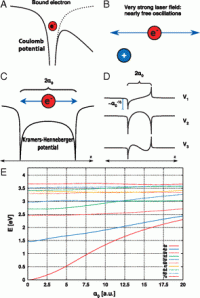October 19, 2011 feature
Eye on ionization: Visualizing and controlling bound electron dynamics in strong laser fields

(������ƵOrg.com) -- Subatomic events can be remarkably counterintuitive. Such is the case in theoretical physics when, under certain specific conditions, atoms exposed to intense infrared laser pulses remain stable rather than undergoing the ionization expected from electric fields at least as strong as the electrostatic forces binding the irradiated valence electrons. Inspired by the observed acceleration of neutral atoms1, and other recent experiments2, researchers at the in Berlin have shown that, in theory, angular resolved photoelectron spectroscopy can be used to directly image these so-called laser-dressed stable atoms.
Today, intense laser pulses with electric fields exceeding the electrostatic fields binding electrons in atoms and molecules have become a routine tool with various applications. Performing research designed by Dr. Olga Smirnova, Dr. Felipe Morales, with Ms. Maria Richter and Dr. Serguei Patchkovskii, conducted in a so-called numerical experiment in which they exposed a potassium atom to a strong laser field and studied the resulting effects. “Naturally,” Morales and Richter explain, “one would think that hammering an atom or molecule with such pulses would lead to fast ionization and overall disintegration of the atomic system. We demonstrate that, surprisingly, the pulse may only flatten the atom, changing its shape without causing it to disintegrate.” Shape refers to the atom’s electronic structure.
“Specifically,” they continue, “the main advance of our work is to show how the electronic structure of this new distorted atom in a superatomic field – the Kramers-Hennerberger (KH) atom – can be directly imaged, within what are now standard experimental conditions.” The existence of the KH atom, although theoretically predicted more than 40 years ago by Henneberger3 and since then the object of extensive research4, has so far remained unconfirmed experimentally. “What we are demonstrating with our work”, stress Morales and Richter, “is that the KH atom is not just an abstract concept formally introduced by theorists, but it is an object, which can be experimentally detected.” In particular, their procedure is based on the calculation of angle resolved photoelectron spectra, which can be obtained with standard femtosecond laser pulses and velocity map imaging techniques2,5.
Paradoxically, the technique of photoelectron spectroscopy is commonly used in weak field experiments, in which the external fields are weaker than the intra-atomic binding fields. However, they demonstrate that the spectroscopic procedure may be applied to interpret the results of strong field experiments. “The analysis of energy- and angle-resolved photoelectron spectra obtained in our numerical experiment”, Morales and Richter note, “allowed us to reveal the signatures of the KH atom.” This accomplishes two things at once: their work demonstrates that strong-field photoelectron spectroscopy can be used to directly visualize the electronic structure of the KH atom and, conversely, the well-defined electronic structure of this exotic atom can be used in order to “read” strong-field photoelectron spectra.
While the group’s research is theoretical, their results are ripe with potential. “Indeed,” Morales and Richter say, “our findings can bring new ideas into the interpretation and the development of visualizing and controlling bound electron dynamics in strong laser fields in various strong-field processes, including a microscopic description of high order Kerr nonlinearities and their role in laser filamentation6 – as well as other highly interesting areas in modern-day physics.”
“Given that this work is purely theoretical,” Morales and Richter conclude, “the question of possible applications will be answered through further research involving collaborations with experimental groups. Our future plans include, for example, the application of our methodology to different systems. We expect to achieve a better insight in interesting phenomena such as laser filamentation and to find explanations for other exciting experimental results by using our approach.”
More information: Imaging the Kramers–Henneberger atom, Published online before print September 19, 2011, PNAS October 11, 2011 vol. 108 no. 41 16906-16911,
Related:
1Acceleration of neutral atoms in strong short-pulse laser fields, Nature 461, 1261-1264 (29 October 2009),
2Photoelectron angular distributions from strong-field coherent electronic excitation, Applied ������Ƶics B 95, 245–259 (2009),
3Perturbation method for atoms in intense laser fields, ������Ƶical Review Letters 21, 838–841 (1968),
4Atomic stabilization in superintense laser fields, Journal of ������Ƶics B: Atomic, Molecular and Optical ������Ƶics 35, R147-R193 (2002),
5Strong-field ionization of lithium, ������Ƶical Review A 83, 023413 (2011),
6Higher-Order Kerr Terms Allow Ionization-Free Filamentation in Gases, ������Ƶical Review Letters 104, 103903 (2010),
Copyright 2011 ������ƵOrg.com.
All rights reserved. This material may not be published, broadcast, rewritten or redistributed in whole or part without the express written permission of ������ƵOrg.com.





















